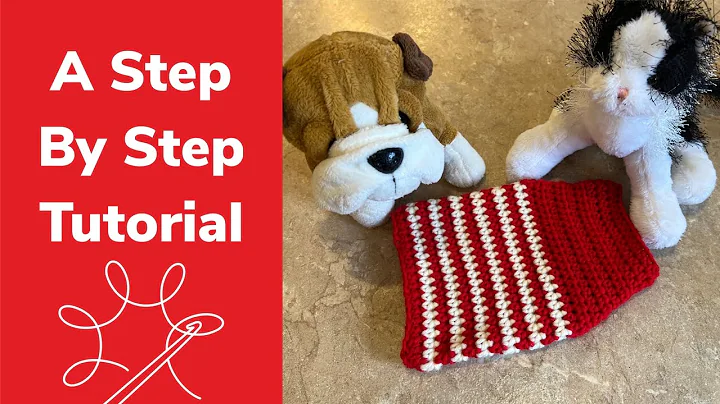Master the Art of Flat Tapestry Crochet
Table of Contents
- Introduction
- Understanding Flat Tapestry Crochet
- Tools and Materials Required
- Basic Crochet Techniques
4.1 Regular Crochet vs. Flat Tapestry Crochet
4.2 Crocheting with Tension and Hook Size
4.3 Switching Colors in Flat Tapestry Crochet
4.4 Dealing with Yarn Twisting
- Following a Pattern in Flat Tapestry Crochet
5.1 Using Graph Paper for Design
5.2 Square Rule Graph Paper vs. Traditional Graph Paper
5.3 Reading a Graph and Identifying Stitches
- Crocheting with Hand Alternation Technique
6.1 Alternate Rose Switch Hands Technique
6.2 Advantages and Disadvantages
6.3 Developing Brain Cells with Non-Dominant Hand Crochet
- Crocheting with Reverse Technique
7.1 Switching from Front to Back
7.2 Developing Different Stitch Looks
7.3 Comparing the Effects of Hand Alternation and Reverse Technique
- Conclusion
- Additional Resources
How to Do Flat Tapestry Crochet: A Comprehensive Guide
Crochet is a versatile craft that offers numerous possibilities for creating beautiful and intricate designs. One interesting technique to explore is flat tapestry crochet. Unlike regular crochet, where the stitches are evenly distributed on both sides of the fabric, flat tapestry crochet allows you to have all the stitches on one side of the cloth. In this article, we will delve into the world of flat tapestry crochet, learning the techniques, tools, and tips required to master this intricate art form.
Introduction
Crocheting has always been a popular craft, with its ability to create stunning and unique pieces. Flat tapestry crochet takes this craft to a new level by allowing you to create intricate designs with all the stitches on one side of the fabric. This technique is perfect for projects like blankets, scarves, and bags that require a dense and sturdy fabric. In this article, we will explore the different techniques involved in flat tapestry crochet and provide you with the knowledge and skills needed to embark on your own flat tapestry crochet journey.
Understanding Flat Tapestry Crochet
Flat tapestry crochet is a technique that involves crocheting with all the stitches on one side of the fabric. This creates a unique and visually appealing texture, making your projects stand out from the crowd. With flat tapestry crochet, you have the ability to create intricate patterns, pictures, and designs, allowing you to personalize your creations and showcase your creativity. This technique requires attentiveness and precision, as each stitch plays a crucial part in achieving the desired design.
Tools and Materials Required
Before diving into flat tapestry crochet, it is important to gather the necessary tools and materials. Here are some essential items you will need:
- Crochet Hooks: Choose hooks of various sizes depending on the project requirements. A larger hook size is recommended for flat tapestry crochet to create loose tension and avoid excessive tightness in the fabric.
- Yarn: Select yarns in different colors to create vibrant and eye-catching designs. It is essential to choose yarns with similar weights to ensure uniformity in your projects.
- Scissors: A sharp pair of scissors will come in handy for cutting yarn and weaving in loose ends.
- Graph Paper: To create intricate designs, using graph paper specifically designed for tapestry crochet can be helpful in visualizing stitch placement and pattern details.
- Tapestry Needles: These needles are used for weaving in loose ends and attaching motifs or appliques to your finished project.
Now that you have gathered the necessary tools and materials, let's move on to exploring the basic crochet techniques involved in flat tapestry crochet.
Basic Crochet Techniques
Regular Crochet vs. Flat Tapestry Crochet
In regular crochet, when reaching the end of a row, the fabric is turned, and the next row is crocheted in the opposite direction. This creates ridges on both sides of the fabric. Flat tapestry crochet, on the other hand, aims to have all the front of the stitches on one side and the back on the other, resulting in a smooth and even surface.
Crocheting with Tension and Hook Size
The tension in your crochet stitches is crucial in achieving the desired outcome in flat tapestry crochet. It is recommended to crochet with a loose tension when working on flat tapestry crochet projects to avoid tightness in the fabric. Using a larger hook size can help in achieving a looser tension and a smoother texture in your finished piece.
Switching Colors in Flat Tapestry Crochet
Switching colors is an essential technique in creating intricate designs in flat tapestry crochet. When switching colors, it is important to do so when two loops are still on the hook. This ensures that the color change is seamless and the stitches remain intact. Additionally, managing yarn twisting is crucial when working with multiple colors. It is recommended to have one color to the right and one to the left, minimizing yarn twisting and ensuring a smooth crocheting process.
Dealing with Yarn Twisting
Yarn twisting can become a challenge, especially when working with multiple colors in flat tapestry crochet. To minimize yarn twisting, try incorporating a little twist when switching colors, allowing the yarns to naturally untwist. However, it is important to be cautious and avoid excessive twisting, as it can lead to tangles and complicate the crocheting process.
Continue reading the full article to explore more techniques, patterns, and tips for mastering flat tapestry crochet.
 WHY YOU SHOULD CHOOSE BEAUTYBADY
WHY YOU SHOULD CHOOSE BEAUTYBADY







